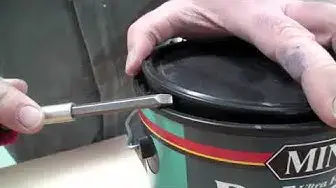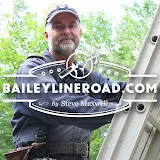MY ONLINE COURSES:
► My Cabin Building Course: https://bit.ly/36bRARX
► MIG Welding for the Home Workshop: https://bit.ly/3CGuUFv
► Woodworking for Beginners: https://bit.ly/3w6ZnLW
► How to Build a Deck: https://bit.ly/3i2LWV3
► Build Traditional Wood Cabinets: https://bit.ly/3JbLQ9v
► Renewable Energy for Your Home: https://bit.ly/3w9K4ls
► 3 Solar Energy Projects: https://bit.ly/3KLNUp9
READ MY POPULAR ARTICLES ABOUT:
► Polyurethane Finish - https://bit.ly/powerbuffing
► DIY Hoop House Plans - https://bit.ly/hoophouseplans
► Submersible Pump Installation - https://bit.ly/pumpinstallation
► Air-Drying Wood Tips - https://bit.ly/wooddrying
► How to Build a Table - https://bit.ly/tablebuilding
► How to Stain a Deck - https://bit.ly/deckstain
► Choosing Waterproof Outdoor Glue - https://bit.ly/exterioradhesives
► How To Build A Wheelchair Ramp - https://bit.ly/wheelchairrampplans
SUBSCRIBE: http://bit.ly/BLRchannel
Show More Show Less View Video Transcript
0:00
I'm Steve Maxwell and I want to show you the secret to making the most of wood
0:10
which is finishing. And finishing that not only looks good, but it's also easy to prepare. I've
0:16
got some samples here of water-based urethane finish that I want to show you. As you can see
0:22
it comes in a whole bunch of different colors. You needn't use these non-traditional colors
0:26
the regular brown, or even unstained and clearly sealed is an option. But whatever you choose
0:33
there are some techniques you have to put into practice if you want that wood to look great
0:39
Let's get started right now with the first part of the process, which is sanding. To show you
0:44
exactly how to apply this kind of finish, I'm going to use this piece of pine board. It's top
0:50
grade wood and it's as smooth as you can expect wood to be coming from the lumberyard, but there's
0:55
still a problem with it. You might be tempted to put a finish directly on this wood, but that would
0:59
be a huge mistake. You'd never get good results unless you do some sanding first. Take a close
1:05
look and I'll show you what I mean. On the surface, if you look closely, you'll see the undulation
1:10
marks left behind by the thickness planer that smoothened this wood. It's those marks that you
1:16
need to take off and the first tool you use for that is the belt sander
1:20
Well, I've just gone over the wood with a 100 grit belt in the belt sander and I've removed all of
1:48
those mill marks you saw a few seconds ago. The thing is though, that the belt sander is still a
1:54
fairly coarse tool. Even if I had a very fine belt on that sander, it's still likely to leave gouges
2:02
and scratches. If I didn't hold the sander exactly parallel to the grain, there's going to be some
2:08
cross-grain scratching there. It's very hard to see at this stage, but it comes right out when you
2:13
put the stain on it. So that's why I have step two, which is using this half sheet vibrating
2:21
sander. The key to using the half sheet vibrating sander is to use it with a light pressure. I've
2:29
got 120 grit sandpaper on here and I was moving it back and forth with the grain. The results are
2:35
considerably smoother than with the belt sander. And to be honest, I could probably go right to
2:41
stain right now, but just to make sure I've got a flawless surface, there is a third sanding step
2:47
It doesn't take very long. It's similar to this one, but it uses a quarter sheet finishing sander
2:52
a palm sander, which we'll also use later on for our between coat sanding. But for now, we're just
2:58
going to use it to refine the wood that last little bit before we start putting some liquid
3:03
on this piece of pine. The quarter sheet finishing sander is a great tool. It's small and light. In
3:19
this case, I've used 180 grit sandpaper for that final sanding pass on the wood before we get to
3:24
the staining and urethane. When I come to use this for sanding between coats, which I'll explain in
3:30
a minute or two, I'll switch to 220 grit paper in that case. If you can, vacuum the surface clean
3:38
Dust is your enemy at this stage. Now if you're working on a job site, you could use a shop vac
3:44
or even a hand broom used vigorously will probably be enough. But sanding wood is entirely different
3:54
operation than finishing wood. Finishing has got to be done in a surgically clean situation
4:01
That's what we're creating now. At this stage, you have a choice to make. Well, you've probably
4:21
made the choice before, but you're going to go in one of two directions right now. You can either
4:25
stain the wood. They've got a range of colors here. There's a traditional brownish color and
4:30
red and a blue, or you can go directly to sealing the finish. You'll need to seal on top of the stain
4:36
too. In this case, we're using a water-based urethane. But if you're going to go with staining
4:43
then there's a step you need to do before you add the color, and that's the application of a pre-stain
4:49
conditioner. What that does is it evens out the absorbency of the wood so you get much more smooth
4:55
color. Water-based products have very low odor and they dry very quickly. You might be wondering
5:08
though, if it's water-based, isn't the finish water-soluble? These products are water-soluble
5:16
and water cleanup when they're wet. But as they dry, they undergo a chemical change that makes
5:24
them insoluble in water. They're actually quite a tough and durable finish. Another advantage is
5:31
that they don't yellow with age. If you want to preserve a very white finish on the wood
5:41
a water-based urethane on its own is the way to go. This is the pre-stain conditioner. I've
5:48
applied an even coat. We're going to let that dry before we come back and put some stain on
5:55
I'm going to let this dry for 15 to 30 minutes before I put the stain on. But before I do
6:02
I'm just going to wipe off all the excess. We don't want any of the pre-stain conditioner
6:08
sealing the surface or forming a film on it. We just want to slake the thirst of that bare wood
6:16
Pre-stain conditioner has done its job. It's soaked in. We've wiped it off. It's dried a
6:22
little bit. If you detect any roughness at all, go over it with a piece of 240-grit sandpaper
6:28
in your hand and that'll remove any of the grain that was raised as it soaked up the water-based
6:35
conditioner. Before you get started with the stain, give it a good stir. There's pigments
6:40
that you need to churn up from the bottom. When the color of the stain becomes consistent
6:46
then you know you've got it completely mixed. Now comes the fun part, putting on some stain
6:54
You want to put it on fairly thick. You're going to wipe it off again just like we did with the
7:01
conditioner. When it goes on, it looks just like paint, but that's not what stain is all about
7:08
When we wipe it, we're going to reveal some of the wood grain underneath and that's what makes
7:15
this combination look so good. The Minwax water-based stains that I prefer come in lots
7:21
of non-traditional colors like you see here, as well as a whole bunch of shades of brown if you
7:27
want to stick with something more conventional. This, of course, is water-based stain that we've
7:32
just put on and it dries fairly quickly, so you don't want to let the stain sit on the wood for
7:37
too long before you wipe it off, revealing that all-important wood grain underneath. And you do
7:44
want to remove everything from the surface. It's only the liquid that's soaked in below the surface
7:51
that you want to remain. We've got the stain on the wood and it's got to be allowed to dry
7:57
completely before the next step. Now one note of caution, this doesn't really look all that
8:03
impressive yet, even though it's a really good staining job. The reason is because it doesn't
8:08
have the depth of color that the urethane brings out. What you need to do next is to coat with one
8:15
coat of urethane and let it dry, then give it another coat of urethane, that's the second one
8:20
and when it's completely dry, lightly sand the surface with 220 grit sandpaper, either in the
8:27
quarter sheet palm sander I showed you before or by hand in any intricate areas. Give it a third
8:33
coat, but don't sand after that last coat. What you're probably going to find at that stage is
8:40
that the urethane looks something like this sample. This is pretty typical, especially when
8:45
you're using water-based urethanes. As you can see, there are some bumps, little specks of dust
8:51
have fallen on the surface and hardened there. Because water-based urethane dries so quickly
8:56
there's likely to be brush marks. If there were any bubbles in the liquid as you put it on
9:03
they might harden in place too. It looks pretty ugly. What you need to do to fix this is something
9:11
I've never seen anyone else do before with water-based urethanes, but it works really well
9:15
And that's using a random orbit sander with a 3M rubbing pad to refine that surface and bring it
9:23
up to a beautiful, shiny, silky gloss like you see here on this sample
#House Painting & Finishing
#Reference



